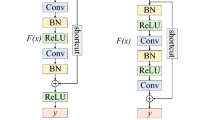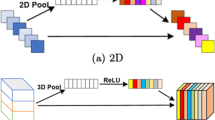Abstract
The hyperspectral image (HSI) classification method based on a three-dimensional convolutional neural network (3DCNN) has problems with overfitting in the training process, and difficulty in interacting with long-distance features, which decreases the classification accuracy. This paper proposes a hyperspectral classification method based on a mix-up algorithm and residual hybrid spectral dilated convolution (M-ResHSDC) to deal with the above problems. Firstly, the mix-up algorithm is utilized for increasing the original dataset to a larger number to alleviate the overfitting problem. Secondly, the hybrid spectral dilated convolution (HSDC) is built up through the combination of the spectral dilated convolution operators with different dilated rates. Each branch of HSDC has a different dilated rate, facilitating the extraction of spectral-spatial features at multiple scales. The ability to capture multiple scales could significantly enhance classification accuracy. On this basis, residual hybrid spectral dilated convolution (ResHSDC) is proposed by replacing the convolution layer of the residual block with HSDC. Thirdly, three ResHSDCs are introduced to replace the three convolution layers of 3DCNN respectively to solve the difficult interaction of long-distance features. Finally, the experiments are conducted on three HSI datasets (Indian Pines, University of Pavia, and Salinas). The results show a higher accuracy of 98.87%, 99.32%, and 99.47% respectively than the traditional methods.














Similar content being viewed by others
Data availability
Publicly available datasets were analyzed in this study. This data can be found here: https://www.ehu.eus/ccwintco/index.php/Hyperspectral_Remote_Sensing_Scenes.
References
Bioucas-Dias JM et al (2013) Hyperspectral remote sensing data analysis and future challenges. IEEE Geosci Remote Sens Mag 1(2):6–36
Kemker R, Kanan C (2017) Self-Taught Feature Learning for Hyperspectral Image Classification. IEEE Trans Geosci Remote Sens 55(5):2693–2705
Lu B et al (2020) Recent Advances of Hyperspectral Imaging Technology and Applications in Agriculture. Remote Sens 12(16):2659
Rao TCM et al (2012) A Hierarchical Hybrid SVM Method for Classification of Remotely Sensed Data. J Indian Soc Remote Sens 40:191–200
Liu G, Wang L, Liu D, Fei L, Yang J (2022) Hyperspectral Image Classification Based on Non-Parallel Support Vector Machine. Remote Sensing 14(10):2447
Bo C, Lu H, Wang D (2018) Spectral-spatial K-Nearest Neighbor approach for hyperspectral image classification. Multimedia Tools Appl 77:10419–10436
Song W, Li S, Kang X, Huang K (2016) Hyperspectral image classification based on KNN sparse representation. 2016 IEEE International Geoscience and Remote Sensing Symposium (IGARSS), pp 2411–2414. https://doi.org/10.1109/IGARSS.2016.7729622
Guo Y, Cao H, Han S et al (2018) Spectral–spatial hyperspectralimage classification with k-nearest neighbor and guided filter. IEEE Access 6:18582–18591
Khodadadzadeh M, Li J, Plaza A, Bioucas-Dias JM (2014) A Subspace-Based Multinomial Logistic Regression for Hyperspectral Image Classification. IEEE Geosci Remote Sens Lett 11(12):2105–2109
Chen Y, Lin Z, Zhao X, Wang G, Gu Y (2014) Deep Learning-Based Classification of Hyperspectral Data. IEEE J Select Top Appl Earth Obs Remote Sens 7(6):2094–2107
Chen Y, Zhao X, Jia X (2015) Spectral-Spatial Classification of Hyperspectral Data Based on Deep Belief Network. IEEE J Select Top Appl Earth Obs Remote Sens 8(6):2381–2392
Makantasis K, Karantzalos K, Doulamis A, Doulamis N (2015) Deep supervised learning for hyperspectral data classification through convolutional neural networks. 2015 IEEE International Geoscience and Remote Sensing Symposium (IGARSS), pp 4959–4962. https://doi.org/10.1109/IGARSS.2015.7326945
Li X, Ding M, Pižurica A (2020) Deep Feature Fusion via Two-Stream Convolutional Neural Network for Hyperspectral Image Classification. IEEE Trans Geosci Remote Sens 58(4):2615–2629
Chen Y, Jiang H, Li C, Jia X, Ghamisi P (2016) Deep Feature Extraction and Classification of Hyperspectral Images Based on Convolutional Neural Networks. IEEE Trans Geosci Remote Sens 54(10):6232–6251
Wu P, Cui Z, Gan Z, Liu F (2020) Residual Group Channel and Space Attention Network for Hyperspectral Image Classification. Remote Sens 12(12):2035
Roy SK et al (2020) HybridSN: Exploring 3-D–2-D CNN Feature Hierarchy for Hyperspectral Image Classification. IEEE Geosci Remote Sens Lett 17(2):277–281
Roy SK, Manna S, Song T, Bruzzone L (2020) Attention-based adaptive spectral–spatial kernel ResNet for hyperspectral image classification. IEEE Trans Geosci Remote Sens 59(9):7831–7843
Yao W, Lian C, Bruzzone L (2021) ClusterCNN: Clustering-Based Feature Learning for Hyperspectral Image Classification. IEEE Geosci Remote Sens Lett 18(11):1991–1995
Chen S, Jin M, Ding J (2021) Hyperspectral remote sensing image classification based on dense residual three-dimensional convolutional neural network. Multimed Tools Appl 80:1859–1882
Zhang C, Li G, Du S (2019) Multi-Scale Dense Networks for Hyperspectral Remote Sensing Image Classification. IEEE Trans Geosci Remote Sens 57(11):9201–9222
Zhang X (2023) Improved Three-Dimensional Inception Networks for Hyperspectral Remote Sensing Image Classification. IEEE Access 11:32648–32658
Li M, Lu Y, Cao S, Wang X, Xie S (2023) A Hyperspectral Image Classification Method Based on the Nonlocal Attention Mechanism of a Multiscale Convolutional Neural Network. Sensors 23(6):3190
Li C et al (2021) Hybrid Dilated Convolution with Multi-Scale Residual Fusion Network for Hyperspectral Image Classification. Micromachines 12(5):545
Cui B, Dong XM, Zhan Q, Peng J, Sun W (2022) LiteDepthwiseNet: A Lightweight Network for Hyperspectral Image Classification. IEEE Trans Geosci Remote Sens 60:1–15
Shi C, Liao D, Zhang T, Wang L (2022) Hyperspectral Image Classification Based on Expansion Convolution Network. IEEE Trans Geosci Remote Sens 60:1–16
Tu C et al (2023) Hyperspectral image classification based on residual dense and dilated convolution. Infrared Phys Technol 131:104706
Ahmad M, Khan AM, Mazzara M, Distefano S, Ali M, Sarfraz MS (2022) A Fast and Compact 3-D CNN for Hyperspectral Image Classification. IEEE Geosci Remote Sens Lett 19:1–5
Shahshahani BM, Landgrebe DA (1994) The effect of unlabeled samples in reducing the small sample size problem and mitigating the Hughes phenomenon. IEEE Trans Geosci Remote Sens 32(5):1087–1095
Liang D et al (2018) Understanding Mixup Training Methods. IEEE. Access 6:58774–58783
He K, Zhang X, Ren S, Sun J (2016) Deep residual learning for image recognition. 2016 IEEE Conference on Computer Vision and Pattern Recognition (CVPR), pp 770–778. https://doi.org/10.1109/CVPR.2016.90
Xu H, Yao W, Cheng L, Li B (2021) Multiple Spectral Resolution 3D Convolutional Neural Network for Hyperspectral Image Classification. Remote Sens 13(7):1248
Wang T, Sun M, Hu K (2017) Dilated deep residual network for image denoising. 2017 IEEE 29th International Conference on Tools with Artificial Intelligence (ICTAI), pp 1272–1279. https://doi.org/10.1109/ICTAI.2017.00192
Author information
Authors and Affiliations
Corresponding author
Ethics declarations
Conflicts of interest
The authors declare that they have no known competing financial interests or personal relationships that could have appeared to influence the work reported in this paper.
Additional information
Publisher's Note
Springer Nature remains neutral with regard to jurisdictional claims in published maps and institutional affiliations.
Rights and permissions
Springer Nature or its licensor (e.g. a society or other partner) holds exclusive rights to this article under a publishing agreement with the author(s) or other rightsholder(s); author self-archiving of the accepted manuscript version of this article is solely governed by the terms of such publishing agreement and applicable law.
About this article
Cite this article
Sun, K., Yin, Y., Dong, F. et al. Hyperspectral classification method based on M-ResHSDC. Multimed Tools Appl 83, 49767–49785 (2024). https://doi.org/10.1007/s11042-023-17515-y
Received:
Revised:
Accepted:
Published:
Issue Date:
DOI: https://doi.org/10.1007/s11042-023-17515-y




